The original Morris Minor.
Visit any classic car show and you'll doubtless trip over a good number of post-war Minors, such as this mid '50s Series 2 Moggie, but go looking for the pre-war Minor, and you could have quite a search. The Austin works at Longbridge were churning out huge numbers of Austin 7s in the 1920s, so naturally William Morris and the Morris Motor Company were keen to get in on the action. In 1928 they launched their Minor, a diminutive motorcar aimed at the private motorist. Whereas the Austin, as did many makers in those days, made do with a sidevalve engine up front, Morris were able to use a modified and smaller version of an overhead cam unit first seen under the bonnet of a Wolseley (the company being part of the Morris empire by this time).
|
|
Initially, buyers could choose from a two door fabric bodied saloon, or a four seat tourer. Two years later the all-steel saloon would go on sale (as shown on this page), as would a tiny van. With braking to all four corners, and the engine producing a modest 20bhp, these Minors were for the most part fairly reliable, although there were issues with the engine, not least its complexity to build, plus some internal oil leak problems. In 1931 a revised version of the engine, this time in sidevalve form, was offered, and the OHC unit was dropped from the market shortly afterwards. A year later, in 1932, the bodyshell was given a gentle make-over, softening some of the edges and bringing things upto date. 1934 would be the final year for the Morris Minor, by which time all models had hydraulic braking (first introduced to the saloon mid-way through production), and a four speed gearbox. Later that same year, the Minor bowed out, to be replaced by the new Morris Eight range.
|
1. An example of all-steel 2 door Minor saloon car
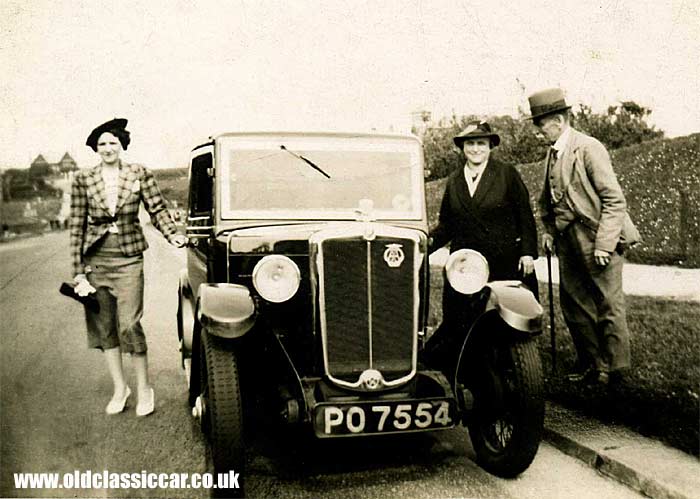
|
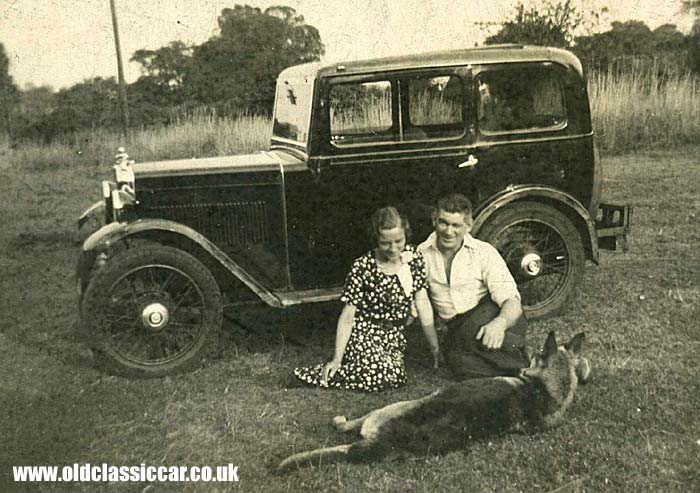
|
|
The first photograph shows an all-steel Morris, registration PO 7554, with three people stood alongside. Note the differing tread patterns on the two front tyres, drivers didn't worry so much about mixing tyre brands in those days. The second picture shows the owner, with lady friend and faithful hound, relaxing alongside the same car.
|
2. A different pre-war Minor photograph surfaces.
Graham sent this black and white photo over, asking if I could identify the car. It shows another example of a pre-war Morris Minor, registered VX 6745, a number hailing from the Essex area. Graham wonders if the car might still be around - a look on the DVLA site doesn't show any record of this car, so chances are it's final journey was to the breaker's yard, unless anyone knows different?
|
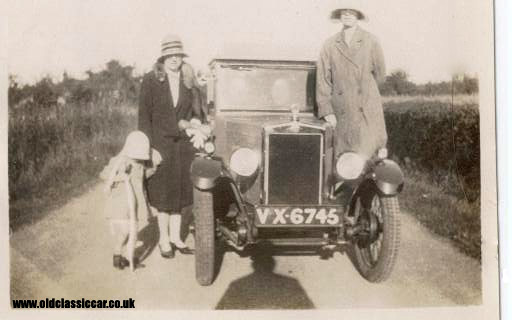
|
3. Another photo of an early Morris Minor saloon.
Vic kindly sent this great photo in. It shows a Morris Minor parked in Kettering, circa 1954, by which time the car was already some 20-25 years old. A close look at the car, a part- fabric covered saloon, reveals some damage to the body covering on the scuttle. VO 1555 is a Nottinghamshire number, it ran from October 1928 through to March 1933, almost mirroring the production run of the Minor itself. Two dapper chaps are photographed with the Minor, the one on the left sporting a fine pair of leather driving gloves. Note how the style of radiator changes throughout the production run of the Minor.
|
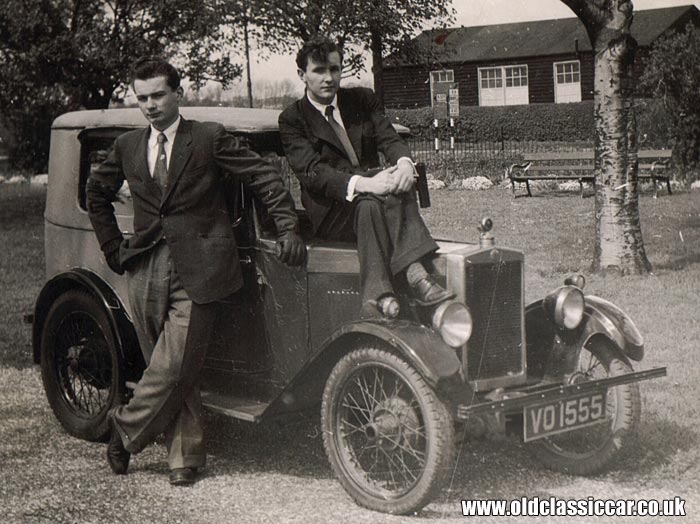
|
4. A Morris Minor parked outside Lincoln prison.
Michael sent this photo over, it shows a pre-war Minor saloon parked outside H.M.P. Lincoln. Quite why the car is parked there, and why someone wanted their photo taken outside the Prison entrance, isn't known sadly (unless perhaps it was on the day of their release??!?). The Morris was registered VL 2893, a Lincolnshire number. It's interesting to note how the style of radiator on these early Minors changed over a production run of just a few years - for instance the Minor in the photo below doesn't feature the chrome radiator surround. The painted surround appeared for 1930, but by 1932 has been dropped in favour of a chrome-plated type. |
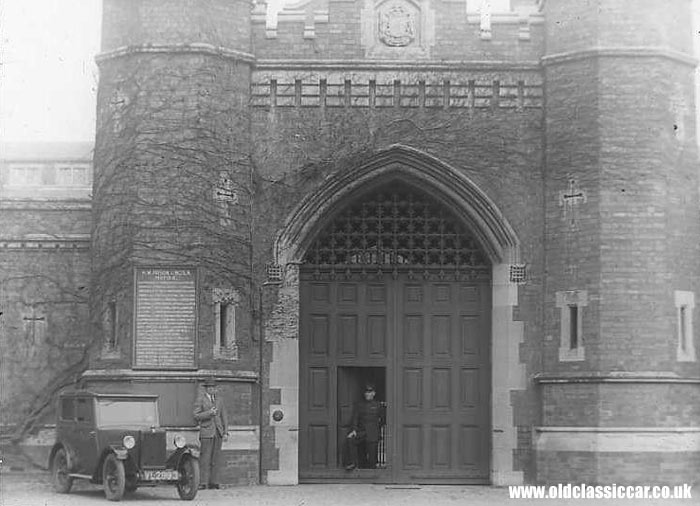
|
5. A family with their pre-war Minor.
This under-exposed old photograph, printed on card, was found in 2010. It shows three children, and their mother, posed with a pre-war Minor saloon. Judging by their dress, the bare trees in the background, and the fitment of a radiator muff on the Morris, it was a cold winter's day.
|
| (Please click the thumbnail to view full-size image.) |
|
|
6. A 1933-season Minor saloon car.
Graham kindly sent this old photo over, wondering what the car was that belonged to his grandfather. It is a Morris Minor saloon, the style of radiator suggests a 1933-season car (identical to the Minor shown at the top of this page). Note the trafficator - on the passenger side only it would seem - and the wartime blackout mask fitted to the nearside headlamp.
|
|
|
7. Two ladies and a vintage Minor.
This next Morris Minor photo isn't the best, but as it shows an early, vintage, Minor, it's worth including here. Giveaways of an early Minor are the wheel centres, sliding door glasses, the peak above the screen, and the radiator, all of which differ on later Minors (such as my '34). It appears to be a seaside location, but sadly no information on the car, or its owner(s), is known. It sports a very unusual radiator mascot - definitely not a Morris fitment, most likely removed from a contemporary Armstrong-Siddeley.
|
|
|
8. A four-seat tourer in a studio.
Posing cars within a photographer's studio, and placing a scenic backdrop on the wall behind, was not all that uncommon in the 1930s, and a number of old photographs like this can be found on the site. Unusually though, this one is dated - 1945 - and the location is given as Blackpool, a popular holiday destination then, and to this day. The un-named girl was aged 12 years at the time of the photograph, sadly we'll never know who she was as no further information is recorded on the picture's reverse.
|
|
The car itself is quite unusual though, in that it is a four-seat tourer version of the pre-war Minor. It even has a tax disc still in the holder, so perhaps this was the studio owner's own car. It also sports a natty pair of full-width wheel discs, an accessory of the era which was designed to modernise the look of cars fitted with spoked wheels. Note the "30 MPH" road sign positioned beyond the car, forming part of the scenery. Troubling speed limits isn't usually a concern for most pre-war Minor owners!
|
|
|
9. A Minor saloon during WW2.
A young couple stand with a blackout-equipped pre-war Minor in the next photo, kindly sent over by Paul Brigden (who, like myself, also owns a Minor from this era). Cars used during the hours of blackout restrictions in the second world war, had to comply with a number of keenly-enforced regulations, designed to minimise the chances of vehicles' headlamps being spotted by enemy aircraft overhead. The compact Morris in the following image has its headlamps covered, save for a tiny slit in the centre. The
edges of the wings (although not the running boards in this instance) have been painted white, to improve the chances of the car being spotted by other
motorists and pedestrians during hours of darkness, while the panel just beneath the radiator has been similar treated. The numberplate is also of the hand-painted variety. Very interesting to see this, thanks for sending it over.
|
|
|
"Choose Morris for Performance" - an advertisement from 1930.
As has been said already, the diminutive Minor underwent regular updates during its life. The following advertisement hails from late April 1930, and draws attention to the Morris' nippy performance and suitability for inner-city driving. "Traffic Agility", we're told, was yours for the taking if you drove the 8hp, overhead cam, powered car. A couple of years later, the OHC engine would be replaced by the simpler, if less adventurous, sidevalve unit, also of 847cc.
|
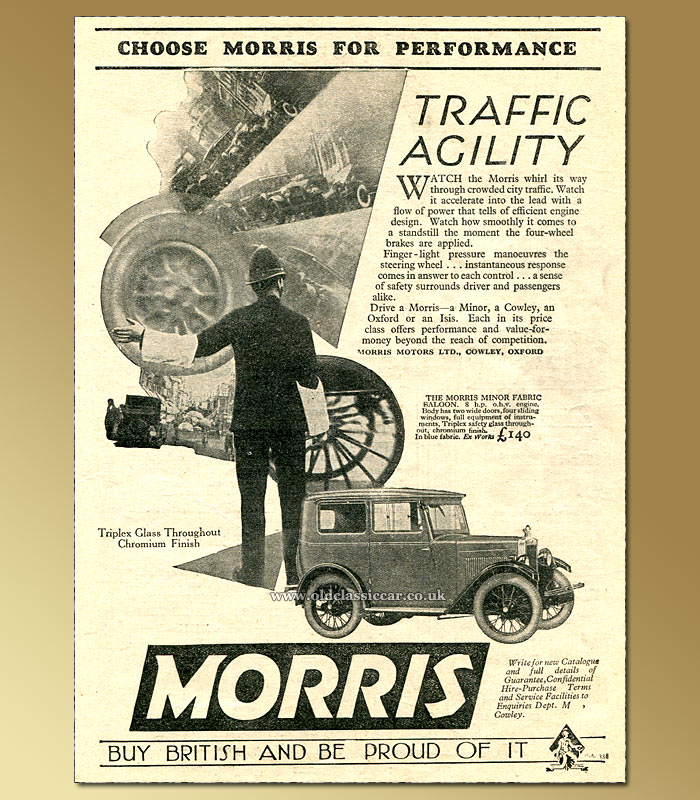
|
|
"Watch the Morris whirl its way through crowded city traffic. Watch it accelerate into the lead with a flow of power that tells of efficient engine design. Watch how smoothly it comes to a standstill the moment the four-wheel brakes are applied."
|
|
"Finger-light pressure manoeuvres the steering wheel ... instantaneous response comes in answer to each control ... a sense of safety surrounds driver and passengers alike."
|
|
"Drive a Morris - a Minor, a Cowley, an Oxford or an Isis. Each in its price class offers performance and value-for-money beyond the reach of the competition."
|
|
MORRIS
|
|
BUY BRITISH AND BE PROUD OF IT
|
|
Return to Old Vehicle Photos Page 6.
|
Other Minor-related items on OCC.
Photographs of the sporty Morris Minor "Semi Sports" can now be seen here, and memories of buying a 2-seat Minor for just five pounds can be discovered here in the Motoring Memories section. Photos of the two-seat Minor tourer will be added to this page.
|
|
An interesting item of correspondence between a Bristol garage and a potential customer, in 1931, regarding the part-exchange of a pre-war Minor against a Singer Junior, may also be found on this page.
|











